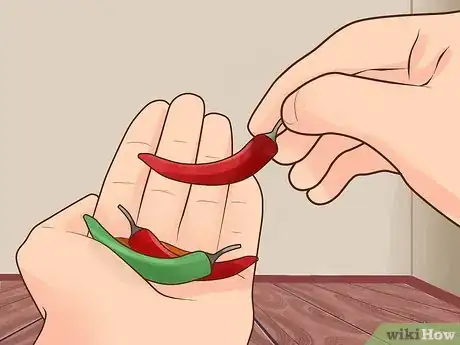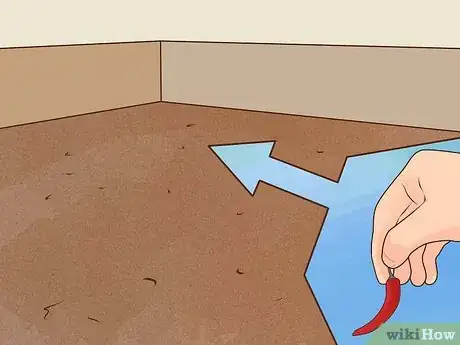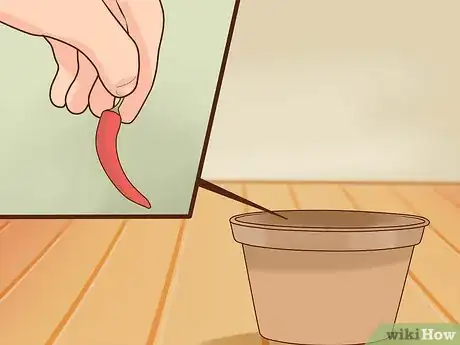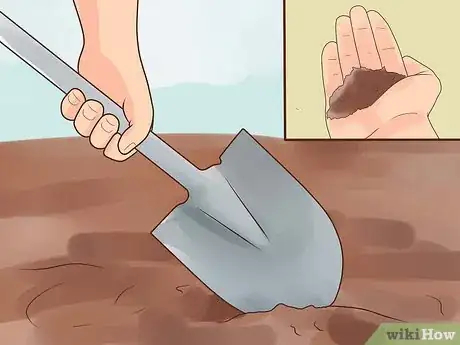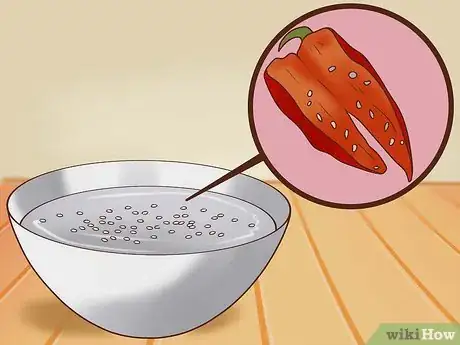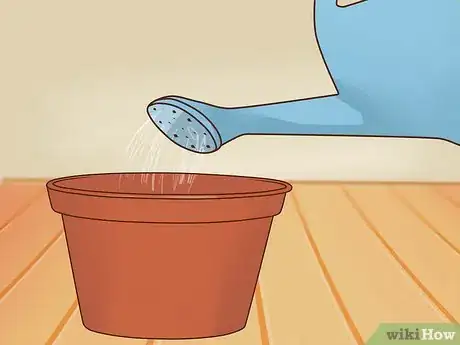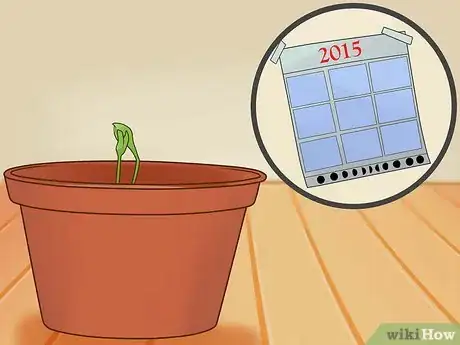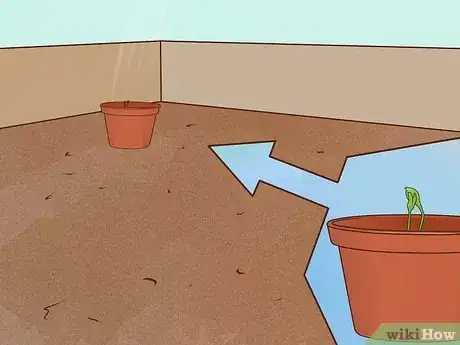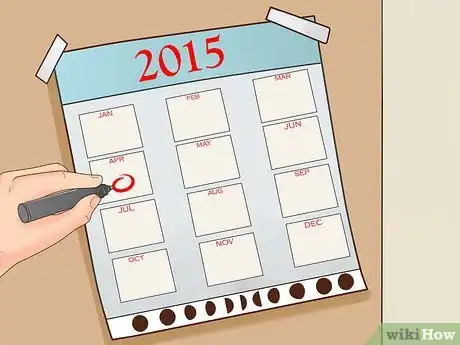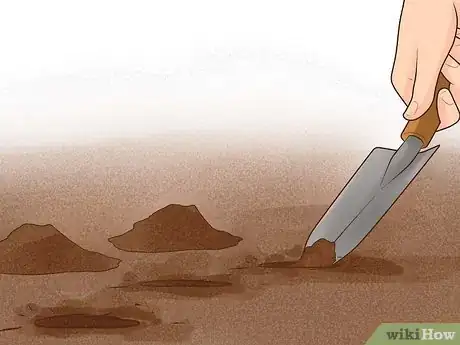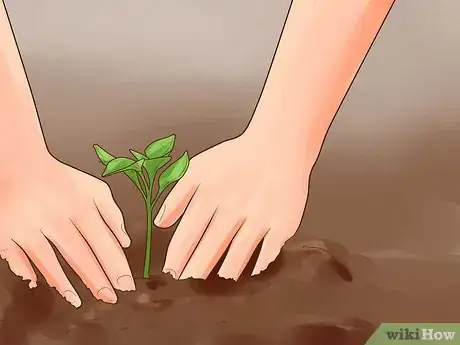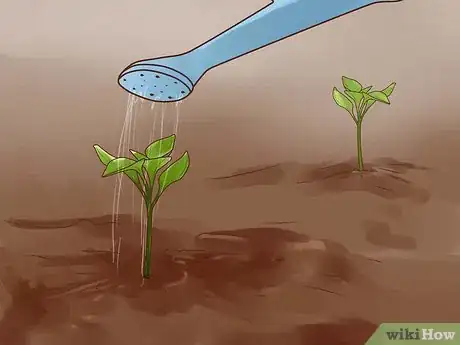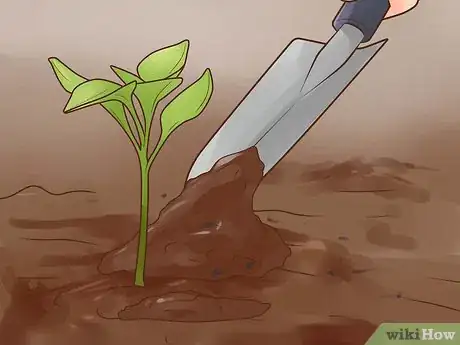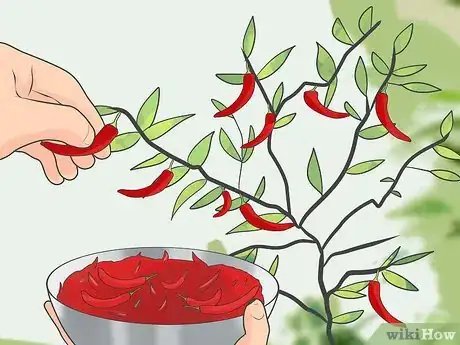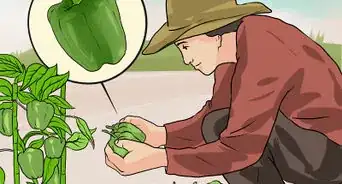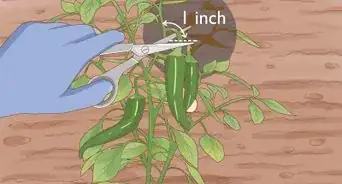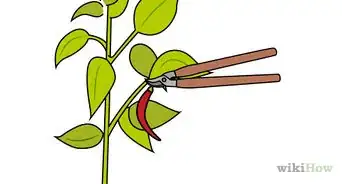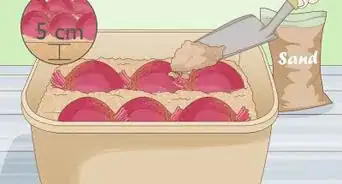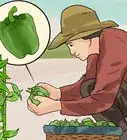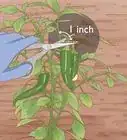This article was co-authored by Andrew Carberry, MPH. Andrew Carberry is a Food Systems Expert and the Senior Program Associate at the Wallace Centere at Winrock International in Little Rock, Arkansas. He has worked in food systems since 2008 and has experience working on farm-to-school projects, food safety programs, and working with local and state coalitions in Arkansas. He is a graduate of the College of William and Mary and holds a Masters degree in public health and nutrition from the University of Tennessee.
wikiHow marks an article as reader-approved once it receives enough positive feedback. This article received 15 testimonials and 88% of readers who voted found it helpful, earning it our reader-approved status.
This article has been viewed 468,337 times.
Chili peppers cover a wide range of peppers under the name Capsicum annuum. They include but are not limited to: Anaheim, ancho, cayenne, jalapeño, habanero and hot banana wax. Chili pepper plants can grow anywhere but they prefer sunny, warm conditions. After growing these plants and enjoying the wonderful taste of chili peppers, you'll wonder why you didn't do it sooner.
Steps
Preparing
-
1Choose a variety of chilies. Chilies are one of the most wonderful plants to grow, because they come in such a wide variety of colours, sizes, tastes, and spice-levels. Chilies can be either an annual (must be replanted each year) or a perennial (grow back on their own). There are also three general types of chili: sweet, hot and ornamental. All three types have some level of spice, but sweet chilies are the mildest, ornamental have lovely colours and shapes (but can be very hot), and hot chilies are used primarily for their intense spice and flavour.
- Chilies range from green, butter yellow, peachy orange, and fire-engine red, to plum and a pitch black hue. The colour doesn't have a direct correlation to the flavour or spice level of each chili pepper.
- Visit a local nursery to find out what variety will thrive in your local environment.
- Certain chilies are used in different areas of the world for special recipes; for example, Serrano chilies are used primarily in Mexican dishes, habanero peppers are common throughout Mexico and Latin America, and the Calcutta pepper is used in Asian curries.[1]
-
2Find the best location for planting. Chilies are heat-loving plants, and are the most successfully grown in areas that have plenty of sun. Choose a plot in your garden that gets full sun or at least mostly sun for the majority of the day. If you live in a desert area, you may need a location with a bit of shade so that the chilies do not get sunburnt. If you live in an area that gets lots of rain, try to find a location in full sun with good drainage; too much water will drown out the chilies and cause them to grow less fruit.Advertisement
-
3Decide if you’re going to start your chilies early indoors. If you don’t live in the traditional chili growing zones (near the equator), then you may benefit from growing your chilies indoors in pots during the winter, and then transplanting them outdoors in the spring when the weather warms up. Although you can certainly just plant your seeds directly into the ground, you might not have as high of chances of them sprouting than if you start them indoors and transplant them as seedlings.
- You can grow chilies from seeds or starts from nurseries, but you’ll have much more variety with growing the former.
- Starting seedlings is easy; just plan it out at least 6 weeks prior to transplanting the chilies outdoors. Chilies can be transplanted outdoors after your area's last frost date.
-
4Amend your soil. The soil in your garden may need to be altered slightly in order to produce the biggest, healthiest, and heartiest crop of chilies. Chilies prefer soil that has good drainage and that has plenty of nutrients. Therefore, mix a bit of sand into your soil to help it to drain better, and incorporate in compost a few weeks or months prior to planting. If your soil has poor or average drainage, you can enhance it by mixing in a bit of sand. If potassium is not already present in sufficient amounts, then you’ll notice a significant growth boost if you increase the amount of potassium in the soil as well. Always test your soil first. If your soil is low in potassium, then visit a local nursery to choose a fertilizer that has lots of potassium and little nitrogen (like a 0-20-0 blend).[2]
- Test the pH of your soil and determine if you need to make further adjustments; chilies like soil that has a neutral or slightly acidic pH of 6.5-7.
- The further in advance you can prepare your soil, the better your chilies will grow.
Starting Seeds
-
1Prepare the seeds. To help make the coating of the seed easier for the new growth to penetrate, you can use a damp paper towel and plastic bag to soften them up. Place a folded damp paper towel in a plastic bag and then place the seeds inside of the towel. Put the bag in a dry, warm place, such as a cupboard in your kitchen and leave them there for two to five days. The seeds should start to sprout within this time frame and then you can plant them.[3]
-
2Plant the seeds in small containers. You can purchase seed trays for your seedlings, or you can simply use individual planting pots for each seed. Fill each small tray or container with your soil (already amended with fertilizer and compost). Then, place a single seed about ½ an inch below the surface of the soil in each container.
-
3Water the seeds. Seeds will need to be watered on a daily basis, so that the soil is kept moist at all times. Give seeds the biggest amount of water after first planting, and then continue adding about a teaspoon of water daily after that.
-
4Place them in a location with heat and sunlight. If you’ve planted seeds before, you may have a heat lamp on hand; heat lamps are perfect for aiding your seeds in growing quickly. If not, place your seeds in a location that gets plenty of sunlight, like a south facing window, and lots of heat, like near a radiator. Just be careful the seeds are neither too hot nor too cold, as both will result in little to no growth.
-
5Watch for the seeds to sprout. It will take anywhere from a few days to a few weeks for the seeds to first sprout. The seeds will sprout a pair of leaves to start, known as ‘seed leaves’. After a bit, a second pair of leaves will sprout; these are known as the ‘true leaves’ and signals that the chilies are ready for transplanting. You can continue waiting for them to grow and for the heat outdoors to rise, or you can plant them as is when their true leaves come in.[4]
-
6Harden off your seedlings. Seeds that are grown indoors are used to a constant temperature with little fluctuation; when they are introduced into the ‘wild’, they can experience a bit of shock from the varying temperatures, moisture levels, and changing sunlight. Harden them off by placing their pots or trays outdoors for a few hours every day. Start at only 2 hours a day for about a week, and then add one hour to each additional day they are placed outdoors until they can stand being outside for a full 24 hours. At this point, they can handle being planted outside without fear of shock.
Planting
-
1Plant at the right time. Wait to plant outdoors until after the last frost of the spring, typically around March or April depending on your local weather. Plant on a sunny day in the late morning or early afternoon when it’s not too hot, so as to avoid transplant shock.
-
2Dig your holes. Chilies should be planted individually to avoid crowding, even if you are planting seeds directly outdoors. Dig small holes slightly larger than your seed or root ball using a garden trowel. These should be spaced about 1 foot (0.3 m) apart, but depending on the type of chili you’re planting the spacing may need to be greater. Research the chilies you’re growing to find out the perfect spacing conditions for your plant.
-
3Plant your chilies. Place each chili plant or seed into the holes you've dug. Replace the soil over the top of each, so that only about ¼ inch of soil is on top of the roots or seeds. Don’t tamp or press down on the soil too much when you’re finished, as the chilies will grow better in loose, well-draining soil.
-
4Water the chilies. Chilies will thrive when their soil is moist, but not soaking wet. After the first planting, give the chilies a bit of extra water to avoid transplant shock. Then, water them on a daily basis so that the soil is damp. If you’re growing sweet peppers, you can make them even sweeter by giving them more water than usual.
-
5Maintain the plants. It will take a month or longer before the chilies begin flowering and bearing fruit, so you will need to maintain their health during this time. Pull out any weeds that you encounter, as these will steal space and nutrients from your chilies over time if you leave them. Incorporate compost and potassium fertilizer into the soil on a monthly basis to keep the nutrient levels high. You can also add a layer of mulch to the top of the soil, to lock in moisture and block out weeds.
- Depending on the type of chilies you are growing, you may need to use a trellis. For example, bell peppers do better with the support of a trellis.
-
6Harvest your chilies. Time to harvest will vary between species of chilies, but you can generally tell when they’re ready by their size. Chilies will change colours, so unless you have a clear idea of what colour the ripe chili will be, don’t rely on colour as an indicator of ripeness. If you’re questioning whether a chili is ripe for picking, give it a taste! You’ll know whether it needs to continue growing for a bit longer, or if it’s ready to make a debut in your kitchen.[5]
- If you're aiming to make chili powder or pepper flakes with your chilies, leave them to shrivel and dry up on their own on the branch before harvesting.
Expert Q&A
Did you know you can get expert answers for this article?
Unlock expert answers by supporting wikiHow
-
QuestionWhat is the best season to plant chillis?
 Andrew Carberry, MPHAndrew Carberry is a Food Systems Expert and the Senior Program Associate at the Wallace Centere at Winrock International in Little Rock, Arkansas. He has worked in food systems since 2008 and has experience working on farm-to-school projects, food safety programs, and working with local and state coalitions in Arkansas. He is a graduate of the College of William and Mary and holds a Masters degree in public health and nutrition from the University of Tennessee.
Andrew Carberry, MPHAndrew Carberry is a Food Systems Expert and the Senior Program Associate at the Wallace Centere at Winrock International in Little Rock, Arkansas. He has worked in food systems since 2008 and has experience working on farm-to-school projects, food safety programs, and working with local and state coalitions in Arkansas. He is a graduate of the College of William and Mary and holds a Masters degree in public health and nutrition from the University of Tennessee.
Food Systems Expert
-
QuestionCan I grow different types of chilis next to each other or will they cross pollinate and change the flavors?
 Andrew Carberry, MPHAndrew Carberry is a Food Systems Expert and the Senior Program Associate at the Wallace Centere at Winrock International in Little Rock, Arkansas. He has worked in food systems since 2008 and has experience working on farm-to-school projects, food safety programs, and working with local and state coalitions in Arkansas. He is a graduate of the College of William and Mary and holds a Masters degree in public health and nutrition from the University of Tennessee.
Andrew Carberry, MPHAndrew Carberry is a Food Systems Expert and the Senior Program Associate at the Wallace Centere at Winrock International in Little Rock, Arkansas. He has worked in food systems since 2008 and has experience working on farm-to-school projects, food safety programs, and working with local and state coalitions in Arkansas. He is a graduate of the College of William and Mary and holds a Masters degree in public health and nutrition from the University of Tennessee.
Food Systems Expert
-
QuestionHow many chilies will each plant produce?
 Community AnswerYou will likely find a range of 15 to 25 per plant. This depends also on how you treat them in terms of watering, fertilizing and general care.
Community AnswerYou will likely find a range of 15 to 25 per plant. This depends also on how you treat them in terms of watering, fertilizing and general care.
Warnings
- Do not touch your eyes when handling chili peppers.⧼thumbs_response⧽
- Give your plants plenty of room to grow as the chili pepper plants can grow up to 3 feet (91.44 cm) high.⧼thumbs_response⧽
- Wear gloves when harvesting chili peppers or you may burn your hands.⧼thumbs_response⧽
Things You'll Need
- Chili Pepper Seeds
- Small Pots
- Potting Soil
- Water
- Gloves
References
- ↑ http://www.tropicalpermaculture.com/growing-chillies.html#growing-chilis
- ↑ http://www.tropicalpermaculture.com/growing-chillies.html#growing-chilis
- ↑ http://www.thechilliking.com/growing/growing-chilli-peppers-guide/
- ↑ http://www.thechileman.org/guide_beginner.php
- ↑ http://www.thechilliking.com/growing/growing-chilli-peppers-guide/
About This Article
To grow chilies, start by finding a sunny indoor or outdoor spot to plant them. Then, after the last frost, plant chili seeds or seedlings in the sunny spot using well-draining soil. Water the chilies every day so the soil is moist but not soaked. You can also apply a potassium fertilizer to the soil once a month to help the chilies grow. Once your chilies flower and bear fruit, harvest the peppers and use them for cooking or making seasonings. If you want to learn how to start your seeds indoors from our Food Systems Expert co-author, continue reading the article!
